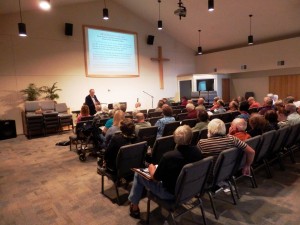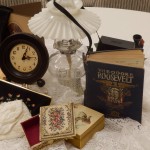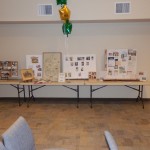About 65 individuals had a difficult time sitting through the Traveling Through Time seminar with speaker William Dollarhide. Within minutes of his opening remarks there was a desire to leave the room and research.
The first session of the all-day seminar was titled “Dollarhide’s Five Rules – Essentials for Successful Genealogical Research.” Rule number 1 was “Treat the brothers and sisters of your ancestors  as equals.” With this rule Dollarhide encouraged everyone to obtain those important census records, vital records, and various historical documents on all collateral lines. He provided a great case study of locating his own Dollarhide Family Bible by following this rule. Most genealogists, he explained, focus so closely on their ancestral line that they overlook the very important clues that are available by examining records left behind by aunts, uncles, and cousins of every generation. With this he also told everyone that they had an awful lot of work to do. It was a difficult way to begin the day as we knew that we were only beginning to understand how little we had done.
as equals.” With this rule Dollarhide encouraged everyone to obtain those important census records, vital records, and various historical documents on all collateral lines. He provided a great case study of locating his own Dollarhide Family Bible by following this rule. Most genealogists, he explained, focus so closely on their ancestral line that they overlook the very important clues that are available by examining records left behind by aunts, uncles, and cousins of every generation. With this he also told everyone that they had an awful lot of work to do. It was a difficult way to begin the day as we knew that we were only beginning to understand how little we had done.
In his second session Dollarhide taught about the American Migration Routes from 1750 to 1800. With easy delivery, as if he was explaining something very simple to an attentive child, he took us on a tour of how one road was built to lead to the need for another, or to connect an already important route. He explained that many of those same routes are still being used today and encouraged us to acquire a 1941 Rand McNally Road Atlas. The Interstate System was not developed until 1956 so many of the most used roads were built on historically proven routes developed over several hundreds of years of travel.
The Civil War created a massive amount of records, many are still available today. Not all of these were federal records either. In Dollarhide’s session titled “Genealogical Resources of the Civil War Era” he gave us information on where to look, both online and on microfilm at the Family History Library, for records created during this time.
The day ended with tools to find living people by using online resources. Dollarhide shared the story of his own research in the 1970s. City directories and telephone books were extremely important and he lived mere blocks away from the Pacific Bell Telephone Company. He spent weeks pouring through various telephone books in order to locate other people with the surname of Dollarhide. The Internet has provided many websites that have taken away the need for telephone books, yet the information is still available if a researcher knows where to look. He endorsed ZabaSearch.com as a free website that was worth a visit that would provide at least a 75% success rate. Pages of additional websites were also provided to help fill in the 25% gap of information.
 The day was packed full with easy to understand methods and freely provided tools. Instead of rushing to research we stayed, partially because we were stunned with the
The day was packed full with easy to understand methods and freely provided tools. Instead of rushing to research we stayed, partially because we were stunned with the  amount of information that we were being given. The other reason we stayed is that the Reata Springs Baptist Church was a wonderful and comfortable venue. The salad and sandwich buffet, stocked by the church’s teens, made a perfect lunch which was enjoyed at round banquet tables decorated with interesting and beautiful historical artifacts. There were Door Prizes, a Silent Auction, and Show and Tell items that also kept our interest.
amount of information that we were being given. The other reason we stayed is that the Reata Springs Baptist Church was a wonderful and comfortable venue. The salad and sandwich buffet, stocked by the church’s teens, made a perfect lunch which was enjoyed at round banquet tables decorated with interesting and beautiful historical artifacts. There were Door Prizes, a Silent Auction, and Show and Tell items that also kept our interest.
When we left we hit the digital highway to look for a variety of documents and information that we may have never really examined before listening to William Dollarhide. We may have even done a few ZabaSearch.com queries to find our long lost friends and tell them about our wonderful day at the Traveling Through Time seminar.
I started working on Rule #1 about a month ago when I got an E-Mail from Family search saying someone had added a source to someone in my tree on Family Search. Probably the most interesting source I found was the 1865 New York Census for my Kelly ancestors. While I knew they were in New York in 1865, I was surprised they stayed long enough to be counted in the census, I thought they were just passing through on there way back to Illinois after leaving the ship from Panama.